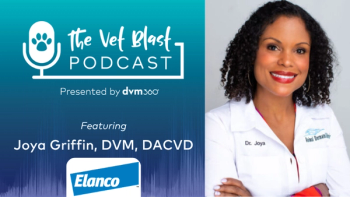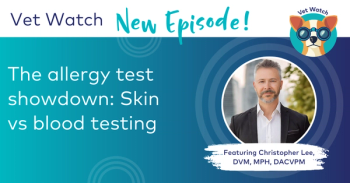
New drugs in dermatology (Proceedings)
In the field of veterinary medicine we see a constant search for newer, more effective, and convenient but inexpensive drugs with lesser side effects. Not only new drugs are interesting, but old drugs are occasionally rediscovered for new indications.
In the field of veterinary medicine we see a constant search for newer, more effective, and convenient but inexpensive drugs with lesser side effects. Not only new drugs are interesting, but old drugs are occasionally rediscovered for new indications. Although many of the new approved drugs available have been thoroughly investigated, reports of the use of older drugs or the use of newer drugs for a different indication are often based on anecdotal reports and need to be further investigated in controlled studies.
Cefovecin sodium (Convenia® Pfizer; 80 mg/ml)
• This is a semi-synthetic cephalosporin with bactericidal effect which inhibits bacterial cell wall syntheses and is relatively resistant to bacterial beta-lactamases. Its main antibacterial spectrum is: gram-negative bacteria (E. coli, Proteus, Klebsiella), gram-positive bacteria (Staphylococci & Streptococci.). Cefpodoxime is not effective against Pseudomonas aeruginosa, Enterococci and methicillin-resistant Staph. Poor efficacy has been shown against anaerobes.
• Indication
o Dogs: skin infections (pyoderma, wounds, abscesses) with Staphylococcus intermedius and Streptococcus canis
o Cats: infections with Pasteurella multocida
• Occasional GI signs (vomiting, diarrhea) may be seen.
• Dosage: 8 mg/kg subcutaneous. Injection can be repeated after 7 to 14 days (very convenient!)
Cefpodoxime proxetil (Simplicef® Pfizer; 100 mg, 200 mg)
• This 3rd generation cephalosporin (antimicrobial activity, see Cefovecin)
• Indication: skin infections (pyoderma, wounds, abscesses) in dogs.
• Drug is well tolerated. Occasionally GI signs may occur.
• Dosage: 5-10 mg/kg orally every 24 hours
Chloramphenicol (Duricol®; 50 mg, 100 mg or Viceton®; 250 mg, 500 mg)
• Broad spectrum antibiotic inhibiting bacterial protein synthesis. Gram-positive aerobic organisms (Streptococci, Staphylococci) are generally susceptible, and many anaerobic bacteria (Clostridium, Bacteroides, Fusobacterium) and organisms such as Nocardia, Mycoplasma, and Rickettsia are sensitive to chloramphenicol.
• Indication: methicillin-resistant Staph. spp. infections
• Usually well tolerated but dose-related bone marrow suppression (reversible) is occasionally seen with longterm use, as well as GI signs.
• Dosage: 30-50 mg/kg orally every 8 hours
• Caution: Can cause irreversible anaplastic anemia in humans!
Cyclosporine (Atopica® Novartis; 25 mg, 50 mg, 100 mg; Neoral®; 100 mg/ml)
• CsA is a naturally produced (fungus: Tolypocladium inflatum) calcineurin inhibitor with anti-inflammatory and immunosuppressive properties focused on cell-mediated immune response.
• Indication: Perianal fistula, canine atopic dermatitis; may also be used for maintenance of auto-immune diseases (e.g. pemphigus foliaceus)
• Since CsA is mainly metabolized through the liver it should be used with caution in patients with liver disease. Many drugs are metabolized through the same cytochrome P450 enzyme system and are able to reduce the metabolism of CsA. The use of ketoconazole at 5 mg/kg orally per day may help to reduce the CsA dose by up to 50%.
• The most common side effects are vomiting, anorexia and diarrhea.
• Dosage: 5 mg/kg orally every 24 hours
Tacrolimus (Protopic®; 0.1% or 0.3% ointment)
• This is a topical calcineurin inhibitor with similar mechanism as cyclosporine. Advantage of calcineurin inhibitors compared to steroids is their lack of cutaneous atrophy and metabolic effects.
• Indication: localized atopy, discoid lupus erythematosus (DLE), pemphigus erythematosus (PE), pemphigus foliaceus (PF), cutaneous idiopathic vasculitis, alopecia areata, Vitiligo. May be also used for maintenance of perianal fistula.
• Increased erythema and irritation can occasionally be observed after starting therapy, but the reaction is transient.
• Dosage: apply daily on affected skin area.
Imiquimod (Aldara®; 5% cream)
• Imiquimod is an immune response modifier which is supposed to stimulate the patient's own immune system to release a variety of cytokines including interferon-alpha and interleukin-12. It does not have direct anti-viral effect, but the drug activates monocytes and macrophages to release cytokines that induce regression in viral protein production.
• Indication: feline herpes virus dermatitis, actinic keratosis, squamous cell carcinoma and Bowen's disease, and viral papilloma.
• Localized irritation and pruritus can occur.
• Dosage: apply once daily to twice weekly on affected skin area.
Trilostane (Vetoryl® Dechra; 30 mg, 60 mg)
• Trilostane is a synthetic steroid analog that acts as a competitive inhibitor of 3-beta hydroxysteroid dehydrogenase, thereby reducing synthesis of cortisol, aldosterone, and adrenal androgens. Inhibition is reversible and dose dependent.
• Trilostane significantly reduces synthesis of progesterone and should not be used in pregnancy.
• The drug is usually well tolerated. Mild lethargy, electrolyte changes, and inappetence can occur initially.
• Indication: pituitary-dependent or adrenal-dependent hyperadrenocorticism, Alopecia X.
• Dosage: 2-20 mg/kg orally once daily with food. Monitor with ACTH-stim test, serum electrolytes (hyperkalemia), and adjust dose based on clinical response.
Spinosad/Milbemycin oxime (Trifexis® Elanco)
• Activates the nicotinic acetylcholine receptors of the flea, resulting in paralysis and death. Kills up to 100% adult fleas within 4 hours.
• Side effects: a few reports of ivermectin toxicity if given in combination with off-label use daily oral ivermectin to treat generalized demodicosis. Should not be given to puppies <8 weeks of age.
• Indication: Flea bite hypersensitivity; for dogs only. Adult fleas, heartworm, intestinal parasites (roundworm, whipworm, hookworm).
Imidacloprid/Moxidectin (Advantage Multi™ Bayer)
• Imidacloprid is a neonicotinoid, which is absorbed upon contact with the flea through the intersegmental membranes. It acts as an agonist on the postsynaptic nicotinic acetylcholine receptors of motor neurons in insects. Imidacloprid is an adulticide and a larvicide. Moxidectin binds to receptors on neuronal membranes of nematodes and muscle membranes of arthropods, causing increased permeability and an influx of chloride ions → hyperpolarization → paralysis → death of parasite. Has also agonist activity at the GABA receptor complex of nematodes and arthropods.
• Indication:
o Imidacloprid: fleas
o Moxidectin: adult nematodes, developmental stages of filarial nematodes (heartworms), mites
• Dosage: once monthly for flea and heartworm prevention, twice monthly for the treatment of mite (e.g. Sarcoptes) infestation. Weekly application may be effective for the treatment of generalized demodicosis.
Doramectin (Dectomax® Pfizer)
• A FDA approved large animal injectable antiparasitic drug, which has been used effectively in the treatment of generalized demodicosis in dogs at a dose of 0.6mg/kg SC once weekly. In the initial studies no increased side effects were noticed. However, it is not recommended to use this drug in ivermectin-sensitive animals.
Interferon alpha 2b (MWI Veterinary Supply)
• Viral infections are known to trigger the production of cytokines, which are synthesized and secreted in response to viral infection, resulting in the inhibition of viral replication. It is also used for immunomodulatory purposes.
• Indication in cats: indolent ulcers, idiopathic facial dermatitis, dermatitis secondary to FHV infection, and atopy. Dogs: Canine Papilloma Virus (30-20,000 IU orally daily)
Newsletter
From exam room tips to practice management insights, get trusted veterinary news delivered straight to your inbox—subscribe to dvm360.






